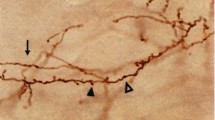Abstract
This work presents unified analyses of spatial and temporal visual information processing in a feed-forward network of neurons that obey membrane, or shunting equations. The feed-forward shunting network possesses properties that make it well suited for processing of static, spatial information. However, it is shown here that those same properties of the shunting network that lead to good spatial processing imply poor temporal processing characteristics. This article presents an extension of the feed-forward shunting network model that solves this problem by means of preprocessing layers. The anatomical interpretation of the resulting model is structurally analogous to recently discovered data on a retinal circuit connecting cones to retinal ganglion cells through pairs of pushpull bipolar cells. Mathematical analysis of the lumped model leads to the hypothesis that X and Y retinal ganglion cells may consist of a single mechanism acting in different parameter ranges. This hypothesis is confirmed in the companion article, wherein the model in conjunction with a nonlinear temporal adaptation mechanism — is used to reproduce experimental data of both X and Y cells by simple changes in morphological and physiological parameters.
Similar content being viewed by others
References
Barlow HB (1953) Summation and inhibition in the frog retina. J Physiol (London) 119:69–88
Baylor DA, Hodgkin L (1974), Changes in time scale and sensitivity in turtle photoreceptors. J Physiol (London) 242:729–758
Boycott BB, Wässle H (1974) The morphological types of ganglion cells of the domestic cat's retina. J Physiol (London) 240:397–419
Carpenter GA, Grossberg S (1981) Adaptation and transmitter gating in vertebrate photoreceptors. J Theor Neurobiol 1:1–42
Cleland BG, Levick WR (1974) Brisk and sluggish concentrically organized ganglion cells in the cat's retina. J Physiol (London) 240:421–456
Dowling JE (1987) The retina: an approachable part of the brain. Belknap, Cambridge
Enroth-Cugell C, Robson JG (1966) The contrast sensitivity of retinal ganglion cells of the cat. J Physiol (London) 187:517–552
Freed MA, Sterling P (1988) The ON-alpha ganglion cell of the cat retina and its presynaptic cell types. J Neurosci 8:2303–2320
Fukuda Y, Hsiao CF, Watanabe M, Ito H (1984) Morphological correlates of physiologically identified Y, X and W cells in the cat retina. J Neurophysiol (London) 52:999–1013
Furman GG (1965) Comparison of models for subtractive and shunting lateral-inhibition in receptor-neuron fields. Kybernetyk 2:257–274
Gaudiano P (1991) Neural network models for spatio-temporal visual processing and adaptive sensory-motor control. Unpublished Doctoral Dissertation, Boston University
Gaudiano P (1992) A unified neural network model of spatiotemporal processing in X and Y retinal ganglion cells. II: Temporal adaptation and simulation of experimental data. Biol Cybern (this issue)
Grossberg S (1970) Neural pattern discrimination. J Theor Biol 27:291–337
Grossberg S (1973) Contour enhancement, short-term memory, and constancies in reverberating neural networks. Studies Appl Math 52:217–257
Grossberg S (1980) Intracellular mechanisms of adaptation and selfregulation in self-organizing networks: the role of chemical transducers. Bull Math Biol 42:365–396
Grossberg S (1983) The quantized geometry of visual space: The coherent computation of depth, form, and lightness. Behav Brain Sci 6:625–692
Grossberg S (1988) Nonlinear neural networks: Principles, mechanisms, and architectures. Neural Networks 1:17–61
Hochstein S, Shapley RM (1976a) Quantitative analysis of retinal ganglion cell classifications. J Physiol (London) 262:237–264
Hochstein S, Shapley RM (1976b) Linear and nonlinear spatial subunits in Y cat retinal ganglion cells. J Physiol (London) 262:265–284
Hodgkin AL (1964) The conduction of the nervous impulse. Liverpool University Press, Liverpool
Koch C, Poggio T, Torre V (1983) Nonlinear interactions in a dendritic tree: localization, timing and role in information processing. Proc Natl Acad Sci USA 80:2799–2802
Kolb H, Nelson R, Mariani A (1981) Amacrine cells, bipolar cells and ganglion cells of the cat retina: a Golgi study. Vision Res 21:1081–1114
Kuffler SW (1953) Discharge patterns and functional organization of the mammalian retina. J Physiol (London) 16:37–68
Lennie P, Trevarthen C, Van Essen D, Wässle H (1990) Parallel processing of visual information. In: Spillman L, Werner W (eds) Visual perception: the neurophysiological foundations, chap 6. Academic Press, San Diego, pp 103–128
McGuire BA, Stevens JK, Sterling P (1986) Microcircuitry of beta ganglion cells in cat retina. J Neurosci 6:907–918
Pinter RB (1985) Adaptation of spatial modulation transfer functions via nonlinear lateral inhibition. Biol Cybern 51:285–291
Rodieck RW (1965) Quantitative analysis of cat retinal ganglion cell response to visual stimuli. Vision Res 5:583–601
Saito H (1983) Morphology of physiologically identified X-, Y- and W-type retinal ganglion cells of the cat. J Comp Neurol 221:279–288
Schiller P (1982) Central connections of the retinal On and Off pathways. Nature 297:580–583
Slaughter MM, Miller RF (1981) 2-Amino-4-phosphonobutyric acid: a new pharmacological tool for retina research. Science 211:182–185
Sperling G (1970) Model of visual adaptation and contrast detection. Percept Psychophys 8:143–157
Sperling G, Sondhi MM (1968) Model for visual luminance discrimination and flicker detection. J Opt Soc Am 58:1133–1145
Sterling P (1990) Retina. In: Shepherd GM (ed) The synaptic organization of the brain, 3rd edn, chap 6. Oxford University Press, New York, pp 170–213
Werblin F (1971) Adaptation in a vertebrate retina: Intracellular recordings in Necturus. J Neurophysiol 34:228–241
Werblin F, Dowling JE (1969) Organization of the retina of the mudpuppy, Necturus maculosus. II. Intracellular recording. J Neurophysiol 32:339–355
Author information
Authors and Affiliations
Rights and permissions
About this article
Cite this article
Gaudiano, P. A unified neural model of spatiotemporal processing in X and Y retinal ganglion cells. Biol. Cybern. 67, 11–21 (1992). https://doi.org/10.1007/BF00201798
Received:
Accepted:
Issue Date:
DOI: https://doi.org/10.1007/BF00201798




